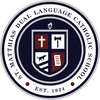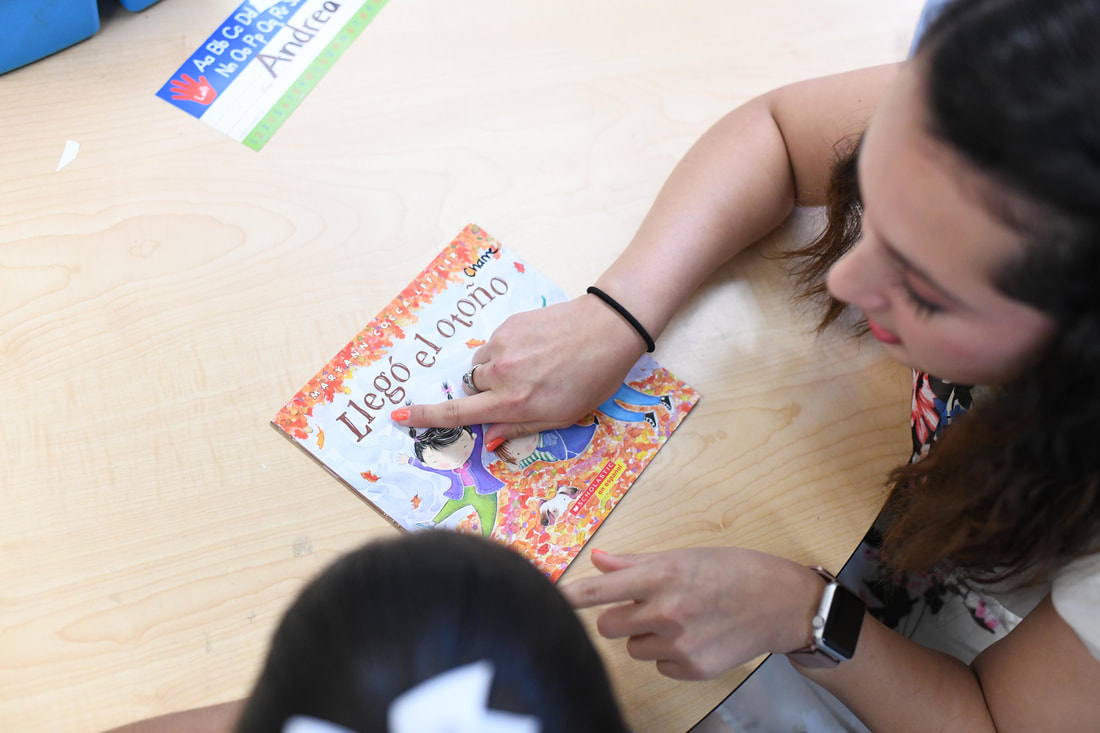Dual Language Immersion
PROGRAM PROGRAMA DOBLE INMERSIÓN EN INGLES Y ESPAÑOL |
STUDENTS LEARN IN SPANISH AND ENGLISH!
FOR THE 2021-2022 SCHOOL YEAR
PRESCHOOL - TRANSITIONAL KINDERGARTEN - KINDERGARTEN - 1ST GRADE - 2ND GRADE - 3RD GRADE - 4TH GRADE - 5TH GRADE
PRESCHOOL - TRANSITIONAL KINDERGARTEN - KINDERGARTEN - 1ST GRADE - 2ND GRADE - 3RD GRADE - 4TH GRADE - 5TH GRADE
The Dual Language Immersion Program at St. Matthias
In 2021-2022 the Dual Language Immersion program encompasses grades Transitional Kindergarten through Fifth Grade. Students in these grades will spend half of the day learning in English and the other half learning in Spanish. For 2022-2023, the Immersion program will continue to sixth grade. In every year after that, the program will grow to one more grade level until it reaches 8th grade. We combine bilingual education, intimate private school setting, and holistic values-based teaching. Interest from native Spanish speaking families as well as non-native speakers of the language has been overwhelmingly positive. School moral, students self perceptions as language learners, and enrollment have all increased since implementing dual language immersion.
Information about Dual Language Immersion Programs
Dual language immersion is a broad term for school models that teach academic content in two languages for at least half of the school day. DLI models vary from 90-10 models that begin teaching the partner language (Spanish, Mandarin, Japanese, Korean or another language the school community chooses) for 90 percent of the day as early as preschool. Each year the percentage of English increases by 10 percent, eventually reaching a 50-50 model in 3rd grade and remaining this way through middle and possibly high school. 50-50 models teach half the day in the partner language and the other half in English, this is the case at St. Matthias. Schools can also be one-way models meaning students enrolled are all native speakers of either the partner language or English. A two-way implies that half of the students enrolled are native speakers of each language, this is the case at St. Matthias.
In 2021-2022 the Dual Language Immersion program encompasses grades Transitional Kindergarten through Fifth Grade. Students in these grades will spend half of the day learning in English and the other half learning in Spanish. For 2022-2023, the Immersion program will continue to sixth grade. In every year after that, the program will grow to one more grade level until it reaches 8th grade. We combine bilingual education, intimate private school setting, and holistic values-based teaching. Interest from native Spanish speaking families as well as non-native speakers of the language has been overwhelmingly positive. School moral, students self perceptions as language learners, and enrollment have all increased since implementing dual language immersion.
Information about Dual Language Immersion Programs
Dual language immersion is a broad term for school models that teach academic content in two languages for at least half of the school day. DLI models vary from 90-10 models that begin teaching the partner language (Spanish, Mandarin, Japanese, Korean or another language the school community chooses) for 90 percent of the day as early as preschool. Each year the percentage of English increases by 10 percent, eventually reaching a 50-50 model in 3rd grade and remaining this way through middle and possibly high school. 50-50 models teach half the day in the partner language and the other half in English, this is the case at St. Matthias. Schools can also be one-way models meaning students enrolled are all native speakers of either the partner language or English. A two-way implies that half of the students enrolled are native speakers of each language, this is the case at St. Matthias.
|
|
|
FREQUENTLY ASKED QUESTIONS
What is Dual Language Immersion (DLI)?
Dual Language Immersion (DLI) is a model of education in which students matriculate through grades TK (or even pre-school) through grade 8 learning content in two languages, English and a Partner Language (e.g. Spanish, Mandarin). Students also experience daily prayers, Masses, celebrations, and performances in both languages. In the early grades, students explore their world guided by teachers using two languages. As they grow, students are taught academic subjects in both English and a partner language. For example, students study math in Spanish while learning history in English.
Why Dual Language Immersion programs?
This particular school model operates on an additive perspective not a deficit. It recognizes that children come to us with language, and just because they may not know English yet, doesn’t mean they start out with a deficit. On the contrary, as mentioned by the National Literacy Panel and the Center for Research on Education, Diversity, and Excellence, these students need to fully develop their native language, have the opportunity to build strong literacy skills so that they can then more successfully acquire their second language. You may be asking well what about students who only speak English and are enrolled in these school models? Research shows that these students continue to show academic gains without a detriment to English.
What are the goals for the Program?
The goals of dual language immersion is bilingualism, biliteracy and biculturalism. In other words by the time students graduate from St. Matthias' dual language immersion program they will be able to listen, speak, read, write and learn academic content in both languages. They will equally learn to embrace differences because this model celebrates exactly this, cultural and language.
What if I don’t know the language?
One of the main concerns for parents in a dual language immersion program is how will I be able to help my child if I don’t know the language? One way that we plan on addressing this concern is that teachers will send a weekly newsletter regarding overarching topics students will be viewing in class. This will include items that will help you engage your child in conversations and ask questions. However, a large part of enrolling in this program is being confident that your child will learn independently of you. Encourage your child to go to class a couple of minutes before school to ask the teacher for help. If they are too young or shy accompany them to ask the teacher for help, eventually they will be asking without your help. This will guide them into becoming independent learners and empower them to take charge of their learning. Also, use other parents in your child’s class as a resource.
What language should I speak to my child in at home?
Speak to your child in the language you feel most comfortable in and read, read, read in that language. Research from the National Literacy Panel and the Center for Research, Education, Diversity and Excellence suggest that students learn their second language best when they have strong literacy skills in their native language. That means that by helping them with their English, you are indeed helping them with their Spanish!
Dual Language Immersion (DLI) is a model of education in which students matriculate through grades TK (or even pre-school) through grade 8 learning content in two languages, English and a Partner Language (e.g. Spanish, Mandarin). Students also experience daily prayers, Masses, celebrations, and performances in both languages. In the early grades, students explore their world guided by teachers using two languages. As they grow, students are taught academic subjects in both English and a partner language. For example, students study math in Spanish while learning history in English.
Why Dual Language Immersion programs?
This particular school model operates on an additive perspective not a deficit. It recognizes that children come to us with language, and just because they may not know English yet, doesn’t mean they start out with a deficit. On the contrary, as mentioned by the National Literacy Panel and the Center for Research on Education, Diversity, and Excellence, these students need to fully develop their native language, have the opportunity to build strong literacy skills so that they can then more successfully acquire their second language. You may be asking well what about students who only speak English and are enrolled in these school models? Research shows that these students continue to show academic gains without a detriment to English.
What are the goals for the Program?
The goals of dual language immersion is bilingualism, biliteracy and biculturalism. In other words by the time students graduate from St. Matthias' dual language immersion program they will be able to listen, speak, read, write and learn academic content in both languages. They will equally learn to embrace differences because this model celebrates exactly this, cultural and language.
What if I don’t know the language?
One of the main concerns for parents in a dual language immersion program is how will I be able to help my child if I don’t know the language? One way that we plan on addressing this concern is that teachers will send a weekly newsletter regarding overarching topics students will be viewing in class. This will include items that will help you engage your child in conversations and ask questions. However, a large part of enrolling in this program is being confident that your child will learn independently of you. Encourage your child to go to class a couple of minutes before school to ask the teacher for help. If they are too young or shy accompany them to ask the teacher for help, eventually they will be asking without your help. This will guide them into becoming independent learners and empower them to take charge of their learning. Also, use other parents in your child’s class as a resource.
What language should I speak to my child in at home?
Speak to your child in the language you feel most comfortable in and read, read, read in that language. Research from the National Literacy Panel and the Center for Research, Education, Diversity and Excellence suggest that students learn their second language best when they have strong literacy skills in their native language. That means that by helping them with their English, you are indeed helping them with their Spanish!
PARENTAL INVOLVEMENT
- Parents can support their child’s language development whether or not they are bilingual/biliterate
- Dual language schooling is a long-term commitment
- The development of bilingualism at a young age has lifelong social and career advantages
- The development of biliteracy has lifelong social, academic, and career advantages
- Experiencing the Catholic faith in two languages has lifelong advantages
THE DUAL LANGUAGE IMMERSION NETWORK

The Dual Language Immersion Schools of the Los Angeles Archdiocese share a common goal; to promote language learning through Roman Catholic traditions and faith. Check out our sister Catholic Dual Language Schools in Los Angeles; All Souls in Alhambra www.allsoulsla.org; Saint Sebastian School in West Los Angeles www.saintsebastianschool.com; Saint Alphonsus School in East Los Angeles www.saintalphonsusschool.org; Saint Paul School in Los Angeles www.stpaulschoolla.org; Our Lady of Perpetual Help in Downey http://www.ourladyschool.com; Saint Patrick School in North Hollywood http://www.stpatrickcatholicschool.com; Saint Joseph School in Pomona http://www.stjosephschoolpomona.org, St. Bernard School in Glassell Park https://www.stbernard-school.com/ and Sacred Heart School in Downtown LA http://www.sacredheartla.org/
Find out more at DualLanguageLA.org
Find out more at DualLanguageLA.org
Find out more about the the best Spanish Immersion school in South Los Angeles by contacting [email protected]



